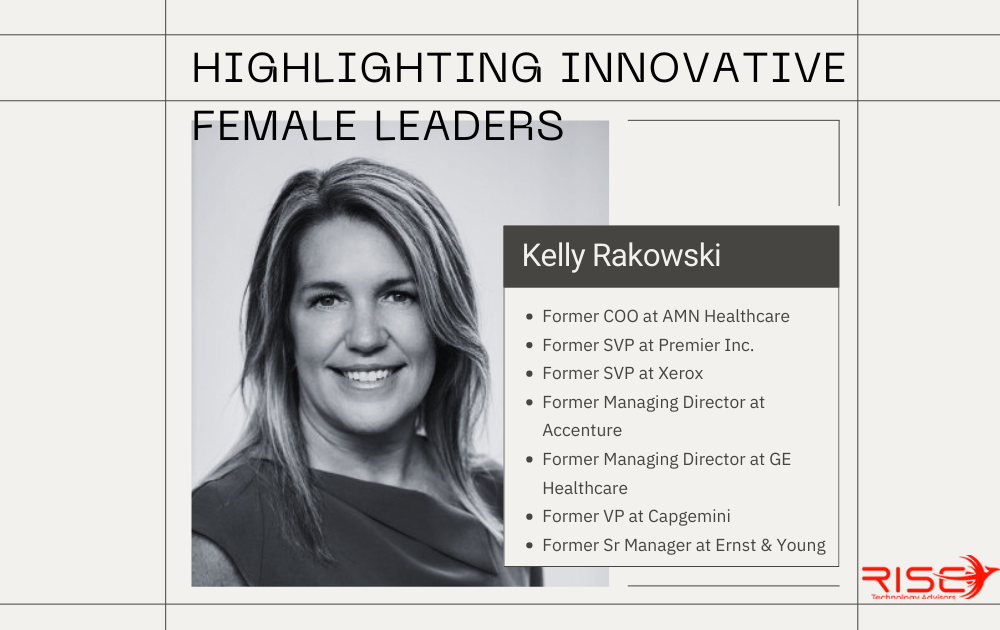Highlighting Innovative Female Leaders: Jill Billhorn
In the fast-paced world of technology, where change is the only constant, leaders like Jill Billhorn have navigated and thrived, helping to shape the way […]

In the world of Human Capital Management (HCM), technology is rapidly reshaping traditional practices. Kelly Rakowski, former COO at AMN Healthcare, and seasoned executive with extensive experience in healthcare technology-enabled services, provided profound insights on the transformative role of technology in HCM, and highlighted her experiences as a woman in leadership.
Transformative Role of Technology in HCM:
The advancement of technology has allowed leaders to become adaptable in high-stress situations. COVID-19 forced organizations to completely adjust how they function short and long-term. Nowhere was that more prevalent than in healthcare staffing which experienced dramatic increases in need. Kelly said of this time “technology played a huge role in helping us innovate very quickly to meet that demand,” highlighting its significance in enhancing operational efficiency and scalability. Kelly identifies three key areas where technology has driven significant change:
Aligning Technological Integration with Organizational Strategies
While technology has brought significant advancements in HCM, ensuring its successful integration requires alignment with organizational needs and workforce expectations. Kelly emphasized the importance of understanding the evolving labor market dynamics and adapting strategies accordingly. She stated, “When it comes to employment, it’s creating very different strategies for organizations as they think about their human capital going forward. In the past we’ve seen very disparate systems to manage human capital that weren’t aligned enough to strategy, to operations, understanding customer demand, and how the workforce was going to either enable or be a barrier to delivering on growth or other strategies for companies.”
To achieve this alignment, Kelly stressed the importance of integrating front-end systems with back-end HCM systems and prioritizing user-centric design, comprehensive training, and ongoing support. She said, “Think differently about labor strategies that are going to be needed, because there is a war for talent and shortages out there are continuing to persist. I think the companies who win are the ones that can, through data and analytics, understand their market, operations, and workforce, bringing those all together into a cohesive strategy going forward.”
Empowering Female Leadership:
Drawing from her experiences as a female leader in technology-driven industries, Kelly acknowledged the existing gender disparities in leadership roles. She highlighted, “We’re still seeing c-suite roles, in particular, filled by a higher percentage of men.” Despite progress, she highlighted the persistence of the glass ceiling and the challenges faced by women, particularly during middle management stages.
In response, Kelly emphasized the importance of advocating for oneself and leveraging support from mentors and sponsors. She encouraged aspiring female leaders to “aim high” and set long-term goals while being flexible in their career paths. Additionally, she highlighted the significance of mentors and sponsors in providing guidance and creating opportunities for advancement. She said, “Your mentors are the people who are really there to help you grow, help push you in your professional development, and challenge you. Successful mentors are a safe sounding board for you along the way. Sponsors are different because they are people who can actually create and give you opportunities. So, you must find sponsors, either inside the organization you’re in or even potentially to the place you want to go. Those people are really critical.”
Throughout Kelly’s career she has been an advocate for mentoring female business professionals and has been an incredible representation of crushing goals, climbing the ladder, and being a successful leader.
In the fast-paced world of technology, where change is the only constant, leaders like Jill Billhorn have navigated and thrived, helping to shape the way […]